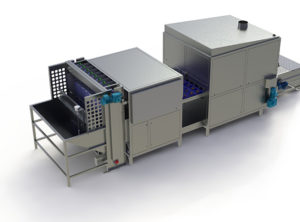Cutting Down to Size: New developments in onion peeling technology, equipment
In today’s competitive market, acquiring and retaining customers can be tough. At the processing level, reducing costs and delivering product of the highest quality is one sure-fire way of doing so – and it starts with the equipment. Three onion peeling technology providers talk about how they meet their customers’ demands. Their latest innovations were on display at Fruit Logistica, an annual trade fair held each year in Berlin, Germany, and Produce Processing was there to gather the story.
The USM-S100 onion peeler by Sormac
Sormac Area Sales Manager Luuk Rutten said their customers are looking for equipment that is economic, ergonomic and environmental. Customers, he said, are also focused on flexibility in equipment that allows them to address consumer awareness issues and better equip them to deal with variable production costs.
“Do not forget that we are processing a natural product that varies per season and per area,” said Rutten.
“We design machines with a small footprint, which are easy to adjust to certain onion sizes,” he continued. “We build machines that are easy to work with and are low in cost per kilogram peeled onion.”
Sormac offers two types of peelers to meet the market’s demand: the USM-S60 and the USM-S100.
The newest peeler, USM-S100, has seen much development, said Rutten. “Our machines have the lowest air consumption, the lowest noise level and can be easily adjusted to the required onion size and skin thickness to create the maximum yield.”
The equipment uses a singulating conveyor belt to transport the onions from the in-feed hopper. The onions are then positioned onto the flights of a transport chain. The operator places the onions in the right horizontal position, and rotating knives top, tail and make a horizontal cut around them.
At the end of the conveying section the onions are picked up with a double holding arm system with rotating holders. During rotation, the onion spins around on its axis while a cut is made over its complete circumference. The depth of that cut is adjustable. Following that, air is blown over the cut onion to remove the skin. Depending on diameter, shape and quality, the USM-S100 can candle up to 4,800–6,000 onions per hour, positioned by one person.
“We keep things simple,” said Rutten. “Our machines are very approachable, easy to maintain and operator friendly.”
TopNotch onion peeler by Finis
Finis, also present at Fruit Logistica in Berlin, showcased their onion peeling technology, TopNotch, which has the capacity to peel up to 12,000 onions per hour.
According to company sales and marketing manager Wouter van Raaij, big onion processing customers have a need for onion peelers capable of peeling large volumes of onions efficiently. They’re looking for machines that produce the highest possible yield, while minimising peeling waste. Further, they’re looking for machines that require low manual labour input and are that are capable of being adjust to their customers’ requirements, if needed. Machines must be flexible, hygienic in design and easy to clean and maintain.
“Finis meets this demand with a range of TopNotch onion peelers available in different capacity ranges,” said Van Raaij. “Different to other concepts, Finis believes in processing onions vertically on indexing plates step by step. This gives a much better control over the onions during processing, and leads to more accurate peeled onions with less waste.”
TopNotch onion peelers use a special coring system for topping and tailing the onions, technology that gives up to 10 percent better yield compared to other topping and tailing systems, said Van Raaij. To reduce labour costs, Finis supplies an automatic orientation system with camera vision technology as an option, for fully automatic orientation and positioning of onions on the indexing plates. This option will save up to two operators. With a special option called “quick change,” onions of two different grades can be peeled, further increasing the machine’s flexibility. Finis peelers are made out of stainless steel open design to give access for proper cleaning. Food safe, FDA approved materials are used.
M&P Engineering’s large onion peeler
Pamela Nugent, managing director at M&P Engineering, said when it comes to onion peeling technology, their customers are looking to reduce labor, improve hygiene, and increase reliability. “Reducing labor cost is the main concern,” she said. “The machine is capable of replacing up to 10 people if customers are currently hand peeling.”
The large peeler will peel a big size range: from 1.75” diameter up to 4.5” diameter. The machine has four settings: small, small-medium, medium-large and large. Grading within 1.25” is recommended to get the best results and reduce trimming and inspection.
“The machine can also peel low-grade, cheaper onions that would otherwise go to waste,” said Nugent.
The new peeler has met improved reliability demands as well. “Reliability is due to the mechanical operation, with only one motor and no PLC to drive everything, it does not require specialist knowledge to service or maintain,” she said. “The design is constantly being improved to reduce maintenance and make it more hygienic with easy clean features.”
When asked about the latest development in onion peelers, Nugent sited pneumatic, user-friendly features, like quick-release changeover for blades. Self-lubricating materials to reduce cleaning and maintenance are also improving equipment. Finally, newer equipment features easy access for cleaning and uses more hygienic manufacturing methods.
Unlike other designs, M&P’s onion peeling machine does not need to hold the onion, which means it has fewer moving parts, making it more reliable.
The original machine, which was developed back in the 1960’s by Mather & Platt, has sold all over the world. “They have simple mechanical principles, which are reliable and produce good results on a wide range of onions,” Nugent explained. “The average customer of the M&P machine is maintaining and servicing the machines in-house, and we have a number of machines still operating for over 30 years.”
— Melanie Epp, contributing writer








